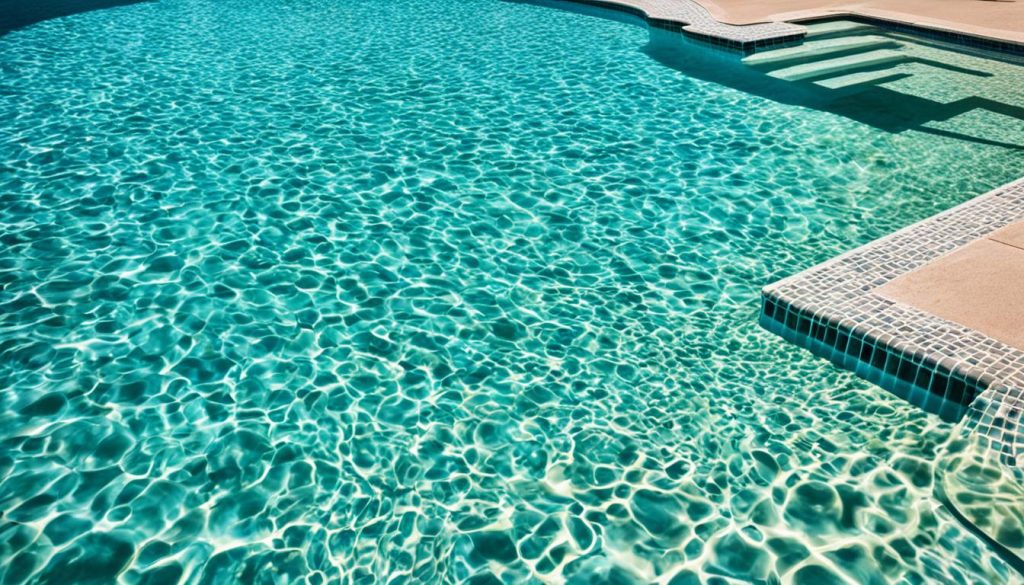As a pool owner in South Africa, the clarity and cleanliness of your swimming pool are a testament to diligent pool maintenance. Algae prevention is a significant aspect of this upkeep, often requiring a combination of strategic measures to keep your pool inviting. Among the arsenal for algae control, utilizing a pool cover presents multiple pool cover benefits. Not only does it act as a physical barrier to contaminants, but it also fulfills a crucial role in regulating the environment that contributes to algae growth.
In addition to shielding your pool from debris, a suitable pool cover can block the sunlight necessary for algae to thrive. With reduced light penetration and debris entry, the task of pool maintenance can become more manageable, and the need for excessive chemical usage can diminish. It’s essential to acknowledge that while covering your pool is beneficial, it’s not a stand-alone solution. Algae prevention requires a holistic approach—inclusive of water chemistry balance and filtration—to ensure a pristine swimming environment.
Key Takeaways
- Proper pool maintenance can be paired with a pool cover for enhanced algae prevention.
- A pool cover blocks sunlight and debris, key contributors to algae growth.
- Pool cover benefits extend beyond algae control, potentially reducing chemical needs.
- Choosing the correct type of pool cover is essential for maximizing algae prevention.
- Comprehensive algae control includes maintaining water chemistry and employing filtration systems.
- Regular and proactive pool care is necessary to prevent the conditions favorable to algae proliferation.
The Constant Battle Against Algae in Pools
Algae prevention is an ongoing challenge for pool owners across the globe. Effective algae control is paramount to ensure that your pool remains clean, clear, and safe for swimmers. To achieve this, a comprehensive strategy that involves regular pool care tips and proactive measures are required year-round, especially as temperatures rise.
Keeping the pool chemistry balanced is the first line of defense against algae infestation. Regularly testing and adjusting the chlorine levels can significantly hinder the proliferation of these unwanted organisms. It’s not solely about periodic checks; maintaining a consistent chemical balance is crucial for algae prevention. Additionally, high phosphate levels serve as a nutrient source for algae, so controlling these levels is an essential step in algae control.
Implementing the right pool care tips can make all the difference. Routine cleaning practices, such as brushing the walls and floor of the pool and ensuring proper filtration function, can remove the existing algae and prevent future growth. Furthermore, the use of an appropriate algaecide as part of your maintenance routine can provide an extra layer of protection to keep your pool in pristine condition.
| Algae Control Method | Description | Frequency |
|---|---|---|
| Chlorine Level Maintenance | Maintain the recommended chlorine levels to continuously sanitize the pool. | Daily |
| Phosphate Level Control | Test and minimize phosphate levels which are algae food sources. | Biweekly |
| Regular Cleaning | Brushing and vacuuming to remove debris and algae spores. | Weekly |
| Algaecide Usage | Employ algaecides as a preventative treatment to inhibit algae growth. | As per product guidelines |
Remember that algae outbreaks can escalate rapidly, leading to murky water conditions that may pose health risks to swimmers. By adhering to these algae control strategies and incorporating these pool care tips into your routine, you can wage a successful battle against algae, keeping your pool inviting and enjoyable all year round.
What Factors Contribute to Algae Growth in Swimming Pools?
Understanding the various factors that contribute to algae proliferation in swimming pools is crucial for effective pool care. A combination of environmental conditions and pool maintenance practices can either discourage or facilitate the growth of algae. To maintain crystal clear and hygienic pool water, it is essential to comprehend algae’s basic needs and the common sources that precipitate their presence in pool environments.
Understanding Algae’s Basic Needs
Algae spores are omnipresent, existing even in the cleanest of pools, biding their time until the conditions are ripe for an outbreak. They require sunlight, warm water, and nutrients to thrive. Without diligent pool maintenance, these simple organisms can quickly turn a pool from sparkling to unsightly. Employing a reliable pool cover for clean water, maintaining proper chlorine levels and temperature, and ensuring good water circulation are the first line of defense in algae control.
Common Sources of Algae in Pool Environments
Algae can be introduced into a swimming pool ecosystem through various means. Rainfall and runoff can carry spores and nutrients into the pool, while high temperatures can accelerate the growth rate of algae. Organic materials, such as leaves and other plant debris, provide the nutrients algae need to flourish, creating a challenge that demands vigilant pool maintenance and the need for efficient pool care tips to prevent contamination.

The table below outlines the common algae types and their sources, as well as preventative measures that should be taken to maintain a clean and healthy pool environment.
| Type of Algae | Sources of Introduction | Preventative Measures |
|---|---|---|
| Green Algae | Plant debris, contaminated equipment or swimwear | Regular use of pool cover, maintaining chlorine levels |
| Yellow Algae | Incorrect pH balance, stagnant water areas | Shocking the pool, thorough brushing and filtration |
| Black Algae | Cracks or crevices in pool surfaces, poor circulation | Algaecide treatment, frequent vacuuming |
| Red Algae | Presence of phosphates, warm water | Phosphate removers, proper sanitization practices |
For pool owners, understanding these algae sources and implementing consistent pool care tips can make a significant difference in the ongoing battle for clean water. The inclusion of a pool cover, alongside routine cleaning and chemical treatment, establishes a robust defense against algae blooms, safeguarding the beauty and usability of the swimming pool all year round.
Does a Pool Cover Help with Algae?
Investigating the multifaceted pool cover benefits leads to an important question for pool owners: does a pool cover assist with algae prevention? A primary advantage of utilizing a pool cover is its capacity to maintain more stable water temperatures, which, alongside diligent pool maintenance, can mitigate the proliferation of algae. Fundamentally, consistent chlorine levels are key to ensuring that algae do not find a hospitable environment underneath the pool cover.
Despite some common concerns, a solar pool cover by itself does not trigger a pool to ‘go green’ with algae. However, if an algae issue is already present, it should be noted that the warmer water created by a solar cover might accelerate its growth. Therefore, the collective realization in the pool community is that a pool cover’s efficiency in algae prevention is crucially complemented by ongoing efforts in pool cleanliness and pool maintenance routines.
Regular pool care, including robust chlorine management and proper filtration, is essential in combating algae spores and creating conditions that are unsuitable for algae growth under a cover.
To depict the relationship between pool covers and algae management clearly, consider the following table, which highlights the required maintenance actions reinforcing pool cover benefits for algae control:
| Maintenance Action | Benefit for Pool Cover Users | Impact on Algae Prevention |
|---|---|---|
| Consistent Chlorine Levels | Optimizes the sanitization potential of covered pools | Directly inhibits algae growth |
| Filtration Practice | Ensures cleanliness irrespective of pool cover usage | Removes algae spores, preventing proliferation |
| Debris Removal | Keeps pool surface under cover clean and clear | Eliminates potential algae nutrients |
| Regular Pool Cover Cleaning | Preserves the integrity of the cover | Discourages algae attachment and growth on cover surface |
In summary, the integration of a pool cover into the pool ecosystem offers pool maintenance professionals and home enthusiasts alike a strategic tool in the constant effort to prevent algae. When implemented with a rounded approach to pool care, the pool cover benefits become a formidable ally in keeping pools clean, clear, and inviting.
Types of Pool Covers and Their Effectiveness Against Algae
When considering pool cover benefits, it’s crucial to evaluate the different types available and their respective roles in pool maintenance and algae control. The choice of a pool cover can substantially influence the ease with which you maintain pool cover for clean water, making the selection process a pivotal part of your pool care routine.
Woven Solid Vinyl Covers for Optimal Algae Control
Woven solid vinyl pool covers are highly esteemed for their robust ability to keep out both sunlight and debris—the two critical elements that algae need to thrive. This type of cover is dense and non-permeable, thereby eliminating sunlight exposure and preventing debris from fertilizing potential algae growth in your pool.
Solar Pool Covers and Algae Growth Dynamics
Conversely, solar pool covers, designed with the primary intent to retain water temperature, also come into play in algae control, albeit with some conditions. These covers must be accompanied by rigorous pool maintenance efforts to ensure chlorine levels remain adequate to prevent algae proliferation.
Below is a comparative look at both types of covers with respect to their algae-preventing attributes:
| Pool Cover Type | Algae Prevention | Key Attributes |
|---|---|---|
| Woven Solid Vinyl Covers | Highly Effective | Blocks sunlight completely, durable, keeps debris out |
| Solar Pool Covers | Variable (Depends on Maintenance) | Retains heat, potential to block some light, requires vigilant chlorine management |
Regardless of which cover you opt for, integrating regular cleaning and balancing of your pool’s chemical levels into your pool care routine will amplify the benefits of a pool cover. Maintaining a sanitized pool environment is synonymous with clean, clear water free from the hassle of relentless algae removal.
Maintaining Your Pool Cover to Prevent Algae
While pool covers offer substantial benefits for water conservation and temperature regulation, their role in algae control should not be underestimated. A clean and well-maintained pool cover is a staunch ally against the ever-present threat of algae, ensuring your swimming pool remains a bastion of clarity and health. Diligent attention to your pool cover’s condition plays a significant part in the overarching regimen of pool maintenance, upholding the aesthetic appeal and hygiene of your pool.
Cleaning and Storage Best Practices
The practice of routinely removing debris such as leaves and twigs from your pool cover cannot be stressed enough. Organic matter can create nutrient-rich pockets that foster algae proliferation if left unattended. Cleaning the cover is not only about removing visible debris, but it is also advisable to clean the cover with mild soap and water to remove any microscopic algae spores before storing. When putting the pool cover away, ensure it is dry to prevent mildew growth, and store it in a cool, dry place away from direct sunlight to retain its integrity and pool cover benefits.
Regular Pool Cover Inspections
Periodic inspections of your pool cover are just as critical as those for the pool itself. Check for signs of wear and tear that could compromise the cover’s ability to prevent sunlight and debris – two key elements in the algae-formation process – from reaching the pool water. Timely identification and repair of any damage are imperative. For those employing solar covers, remember to remove them before performing shock treatments to ensure that the high chlorine concentrations do not harm the cover material. Through these proactive measures in pool maintenance, you are actively safeguarding your aquatic retreat against the unsightly and troublesome nuisance of algae.
